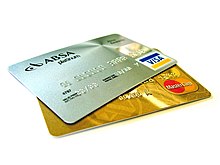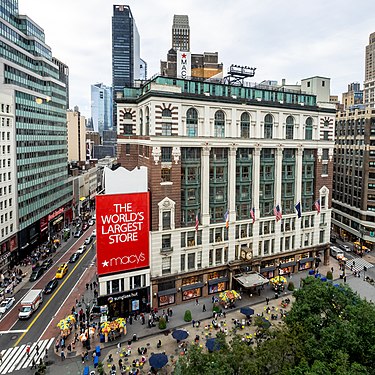English as an Additional Language/Stores, Shopping and Money
Stores are places that sell things. People go to stores to buy things. There are many different types of stores. Each store sells different things. Some stores sell clothes, others sell electronic equipment, and still others sell food, or toys.
Ways to pay[edit | edit source]
People use money to pay for things, both in person and through virtual platforms.
Cash[edit | edit source]
Cash is a type of money that is very easy to use. Cash includes paper bills and metal coins. In the United States, cash is also called legal tender and is issued by the US Treasury.
Some businesses are Cash only, and you can only pay in cash. Some businesses will offer a discount or lower price for paying in cash. Some businesses do the opposite and are Cashless - they refuse payment in cash.
Because of it's importance, cash is often refereed to by slang terms such as:
- Dough
- Greenbacks
- Moolah
- Bread
Check[edit | edit source]
Another common way to pay for things is with checks. Customers go to banks to open checking accounts, or bank accounts that have checks. Checks are pieces of paper that people give to stores instead of cash. Stores then take the checks to the banks. Then, the banks give the stores money from the bank accounts of their customers.
Cards[edit | edit source]

The other main way that people pay for things is with cards. A card is a thin piece of plastic that some banks or credit unions issue to their customers. Customers can use cards to buy things more quickly than with checks. Cards come in a variety of forms:
- Credit Cards - These cards allow a user to pay off purchases at the end of the month.
- Debit Cards - These cards can be used to pay directly from a checking account.
- EBT Card - Short for Electronic Benefit Transfer card. These cards are used by those on welfare to make essential purchases.
- Prepaid Cards - These cards are loaded with a balance, and are then usable at stores. These include two types of cards:
- General: Branded by a credit card processor, and generally usable anywhere that supports that processor.
- Gift Cards: Usable only at specific stores.
Electronic[edit | edit source]
Another way to pay is by using a payment app on a smartphone, or an online payment website.
Kinds of stores[edit | edit source]
For an overview, retail markets, boutiques, and shops have a very ancient history, dating back to antiquity. Some of the earliest retailers were itinerant peddlers. Over the centuries, retail shops were transformed from little more than "rude booths" to the sophisticated shopping malls of the modern era. In the digital age, an increasing number of retailers are seeking to reach broader markets by selling through multiple channels, including both bricks and mortar and online retailing. Digital technologies that are also affecting the way that consumers pay for goods and services. Retailing support services in many ways may also include the provision of credit, delivery services, advisory services, stylist services and a range of other supporting services.
Most of these modern retailers typically make a variety of strategic level decisions including the type of store, the market to be served, the optimal product assortment, customer service, supporting services, the product variety, and the store's overall market positioning that will indeed impact the future of community success. Once the strategic retail plan is in place, retailers devise the retail mix which includes product, price, place, promotion, personnel, and presentation.
Most stores sell new things but some stores sell old or used items. The advantage of buying used things is that they are cheaper (that is, less expensive). In America, stores sell used books, used clothes, used cars and very old used furniture and other things. Very old used things are called antiques.
Stores are usually physical places but are sometimes virtual places. Online stores[1] are Internet sites where people can buy things. One of the most famous virtual stores is Amazon.com, a web site that sells books and many other things.
Bookstores[edit | edit source]

There is also a store that sells books and other print media called, bookstores. A bookstore is a store that sells books, and where people can buy them. A used bookstore or second-hand bookshop sells and often buys used books. Bookstores also may contain cafés, play spaces, and reading rooms.
Bookstores doesn't just sell books, they sell magazines, newspaper, DVDs, CDs, Manga, graphic novels, gifts, games, toys, music, brochures, postcards, gift cards, essays, academic journals, textbooks, encyclopedias, dictionaries, travel guides, physical art, Blu-ray, ARCs, merchandise, listicles, stickers, notebooks, almanacs, workbooks, newsletters, radios, podcasts, RSS feeds, and tablets and much more.
Luxury[edit | edit source]

People go to expensive stores to buy luxury items. This makes them feel good. Nice stores like this are often at malls or shopping centers. Rich Americans buy many luxury items, and so do many lower-income Americans, too. The United States is a consumer society, where people use the money that they make to buy more and more consumer products.
Taxes and Duty Free[edit | edit source]
Many governments impose a Sales Tax on goods. In some parts of the English speaking world the tax is included in the price shown to the customer. In other parts of the English speaking world, the tax is only shown to the customer at the checkout.
Some items may be tax exempt, meaning tax is not charged. These are typically items considered essential, such as groceries, or school supplies.
Other items may have an excise tax, meaning these are charged a higher tax then usual. These are typically applied to alcohol and tobacco.
On the border and in places where international transit happens, it is sometimes possible to find Duty Free shops, where no or lower tax is charged at the store. This is usually done with the expectation that the tax will be paid when entering the destination country.
Going Shopping[edit | edit source]
When people go to a store to buy things they say that they are going shopping. When people look for things at a store it is called browsing or window shopping. Sometimes Americans do this as a pleasure activity or to relax. Because of this, people sometimes criticize Americans as being materialistic.
Checking Out[edit | edit source]

The part of a store where customers pay is called the check-out counter or check-out aisle. There, a clerk, sometimes called a cashier, helps ring up the products to register their prices. To do this, the clerk uses a cash register. If the cash register is computerized, the clerk uses a scanner to ring up the prices. Paying at the register is also called checking out.
Lines and Queues[edit | edit source]
Sometimes lines of people at the register are long. Some English speaking areas call these such a line a queue, where others simply call it a lone. When this happens, it takes a lot of time to pay and customers have to wait for several minutes. This can be stressful, but many stores place small trinkets, snacks, and magazines here to entice customers to make one last purchase.
Self Checkout[edit | edit source]

Some stores have done away with the cashier, and have the customer perform a checkout themselves.
A useful feature of these machines is that some are multilingual, and can help learners complete their purchase more easily in their native tongue. However this feature is not always available, nor does it include all languages.
Tipping[edit | edit source]
Tipping is an important part of some kinds of shopping in certain areas of the English speaking world.
Picture Guide[edit | edit source]
-
A Supermarket sells groceries and a variety of other items.
-
A Department Store sells a wide variety of items.
-
A Convenience Store sells a small selection of commonly needed items. They are often located at Gas Stations which sell gasoline/petrol and diesel.
-
A Pharmacy sells medicine, both over the counter and prescription medication.
-
A Thrift Shop sells used items at reduced prices.
Notes and References[edit | edit source]
- ↑ Also commonly known as Virtual Stores, Web Stores, among other names.




